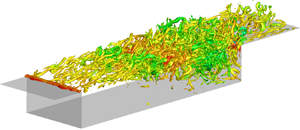Article contents
Unsteady control of supersonic turbulent cavity flow based on resolvent analysis
Published online by Cambridge University Press: 19 August 2021
Abstract

We use resolvent analysis to develop a physics-based, open-loop, unsteady control strategy to attenuate pressure fluctuations in turbulent flow over a rectangular cavity with a length-to-depth ratio of  $6$ at a Mach number of
$6$ at a Mach number of  $1.4$ and a Reynolds number based on cavity depth of
$1.4$ and a Reynolds number based on cavity depth of  $10\,000$. Large-eddy simulations (LES) of the baseline uncontrolled flow reveal the dominance of Rossiter modes II and IV that generate high-amplitude unsteadiness via trailing-edge impingement and oblique shock waves that obstruct the free stream. To suppress the oscillations, we introduce three-dimensional unsteady blowing along the cavity leading edge. We leverage resolvent analysis as a linear model with respect to the baseline flow to guide the selections of the optimal spanwise wavenumber and frequency of the unsteady actuation input for a fixed momentum coefficient of 0.02. Instead of choosing the most amplified resolvent forcing modes, we seek a disturbance that yields sustained amplification of the primary response mode-based kinetic energy distribution over the entire cavity length. This necessary but not sufficient guideline for effective mean flow modification is evaluated using LES of the controlled cavity flows. The most effective control case reduces the pressure root mean square level up to
$10\,000$. Large-eddy simulations (LES) of the baseline uncontrolled flow reveal the dominance of Rossiter modes II and IV that generate high-amplitude unsteadiness via trailing-edge impingement and oblique shock waves that obstruct the free stream. To suppress the oscillations, we introduce three-dimensional unsteady blowing along the cavity leading edge. We leverage resolvent analysis as a linear model with respect to the baseline flow to guide the selections of the optimal spanwise wavenumber and frequency of the unsteady actuation input for a fixed momentum coefficient of 0.02. Instead of choosing the most amplified resolvent forcing modes, we seek a disturbance that yields sustained amplification of the primary response mode-based kinetic energy distribution over the entire cavity length. This necessary but not sufficient guideline for effective mean flow modification is evaluated using LES of the controlled cavity flows. The most effective control case reduces the pressure root mean square level up to  $52\,\%$ along cavity walls relative to the baseline and is approximately twice that achievable by comparable steady blowing. Dynamic mode decomposition on the controlled flows confirms that the optimal actuation input indeed suppresses the formation of the large-scale Rossiter modes. It is expected that the present flow control guideline derived from resolvent analysis will also be applicable at higher Reynolds numbers with the aid of physical insights and further validation.
$52\,\%$ along cavity walls relative to the baseline and is approximately twice that achievable by comparable steady blowing. Dynamic mode decomposition on the controlled flows confirms that the optimal actuation input indeed suppresses the formation of the large-scale Rossiter modes. It is expected that the present flow control guideline derived from resolvent analysis will also be applicable at higher Reynolds numbers with the aid of physical insights and further validation.
Information
- Type
- JFM Papers
- Information
- Copyright
- © The Author(s), 2021. Published by Cambridge University Press
Footnotes
Present address: Department of Mechanical and Aerospace Engineering, The Ohio State University, Columbus, OH 43210, USA.
Present address: Department of Mechanical and Aerospace Engineering, Syracuse University, Syracuse, NY 13244, USA.
References
REFERENCES
- 44
- Cited by


